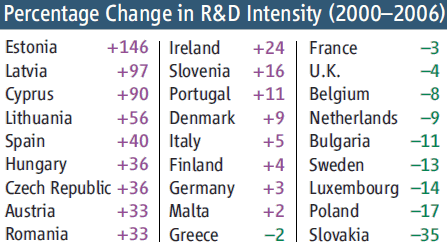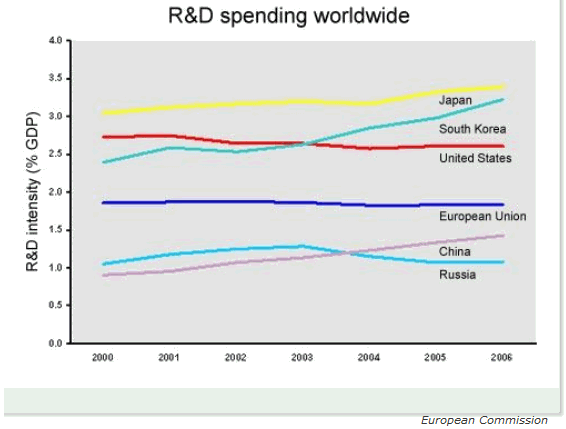|
|
|
|
|
|
|
News & Views item - February 2009 |
![]() European Union Releases Report on 27 E.U. Nations' Research Efforts.
(February 14, 2009)
European Union Releases Report on 27 E.U. Nations' Research Efforts.
(February 14, 2009)
On the plus side the report notes that between 2000 and 2006, the EU's research work force reached 640,000 and the numbers of foreign researchers increased together with Europe attracting record amounts of private R&D funding from U.S.
However, the report also points out that what it refers to as "R&D intensity"
(the percentage of GDP spent on R&D) continued to hover around 1.84%.
As Science points out in its January 30, 2009 issue: "That's a long way from the E.U.'s self-imposed goal of reaching an R&D intensity of 3% by 2010."
Pierre Papon, professor at the Ecole Supérieure de Physique et de Chimie Industrielles, and a previous director general of the CNRS Paris, wrote in an August 2003 Editorial for Science: "In March 2000, European heads of governments and of states agreed in Lisbon that by 2010, the European Union (EU) should become "the most competitive and dynamic knowledge-based economy in the world... To implement this objective, they agreed in Barcelona in 2002 to devote 3% of their gross domestic product (GDP) [by] 2010 to R&D and to foster common science policies in a 'European Research Area,' as proposed by EU research commissioner Philippe Busquin."
Science's Daniel Clery sums up: "Across the E.U., there is much variation in R&D intensity, with 17 countries, particularly new members in eastern Europe, making marked improvements. But 10 countries, including science powers such as France and the United Kingdom, declined. Meanwhile, Japan increased its intensity from 3.04% to 3.39%, Korea from 2.39% to 3.23%, and China from 0.90% to 1.42%. (U.S. research intensity fell, from 2.74% to 2.61%.)"
Interestingly, if Australia had a mind to, it is in a good position to catch up and quickly.
